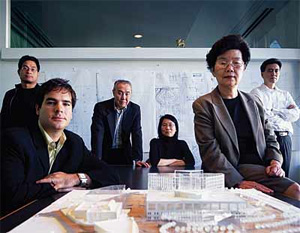Just when did this all begin to shift around? Was it when back in 1987 when Gehry, known then for his “chain-link architecture,” and David Childs, of Skidmore, Owings & Merrill’s New York office, went after the Madison Square Garden competition? The scheme didn’t go anywhere, but the architectural community took note of the new bedfellows.


The appearance of the high-design architect—say Frank Lloyd Wright or Le Corbusier—being summoned to take up a major commission in foreign city is hardly new; it happened with Wright in the Imperial Hotel in Tokyo in 1915, and Le Corbusier, in a diminished role at the United Nations headquarters in New York from 1947 to 1953. Nor is the cobbled-together collaboration novel: Around 1954, when Mies van der Rohe came to New York City from Chicago to design the Seagram Building, Kahn and Jacobs was brought in as associate architect to oversee the production phase, and, in an unusual move, Philip Johnson was hired as a “co-design architect.” Since Mies didn’t have a New York State license at that time, he needed Kahn and Jacobs to sign the drawings. And Johnson, himself in the process of getting his license, was perceived as a proper enough Miesian disciple to carry out the master’s design in the event the 68-year-old architect had a tough time making the long commute.
In the post–World War II decades, Eero Saarinen, Edward Durell Stone, and Louis Kahn famously exported their architecture abroad, and by the 1980s, American architects had taken over the world. Then the tide began to turn in the 1990s, as European and Asian architects invaded the U.S., with museums as their noticeable foothold. Added to this has been the desire for American cities and towns—and those abroad—to repeat the Bilbao experience, where Frank Gehry’s Guggenheim Museum in 1997 transformed a decrepit downtown into a tourist attraction. Now both American and European superdesigners are airlifted into U.S. cities and towns to revitalize them with spectacular architecture. These “names” seek to ally themselves with an office they can trust to carry out their ideas, while their clients naturally want someone at their beck and call.
Box office bonanza
Today’s clients of architecture, like Hollywood studios, find great appeal in box-office names and, as several architects note, are more willing to pay higher architectural fees when a star is involved. It makes it easier to raise money for cultural projects, and private developers are even betting on name designers to sell condominiums.
The joined-up architects can do well financially: A fee for architectural services could be, for example, 6 percent of construction plus 15 percent over prime because, so the argument goes, the client is getting two quality architects almost for the price of one.
It should be underscored that box-office architecture hardly means the star architects get tons more money than anyone else. Indeed, the supporting cast––the collaborating architects––often get 60 percent of the architectural fee, compared to the design architects’ 40 percent. In many cases that fee is split 50-50, with the associated architect in charge of check writing. Says David Fong, AIA, of Fong & Chan, in San Francisco, which has associated with Norman Foster, Robert A.M. Stern Architects, and lately Herzog & de Meuron on the de Young Museum, “Herzog & de Meuron was a bit reluctant about our getting more money. But we held the contract and we get the lawsuit if anything goes wrong.” Ronnette Riley, FAIA, whose design-oriented New York firm has collaborated with other design offices, adds, “The pay scale and rent in a particular city like New York add to the cost of doing business. You have to factor this into your calculations when splitting the fee with an out-of-town architect.”

